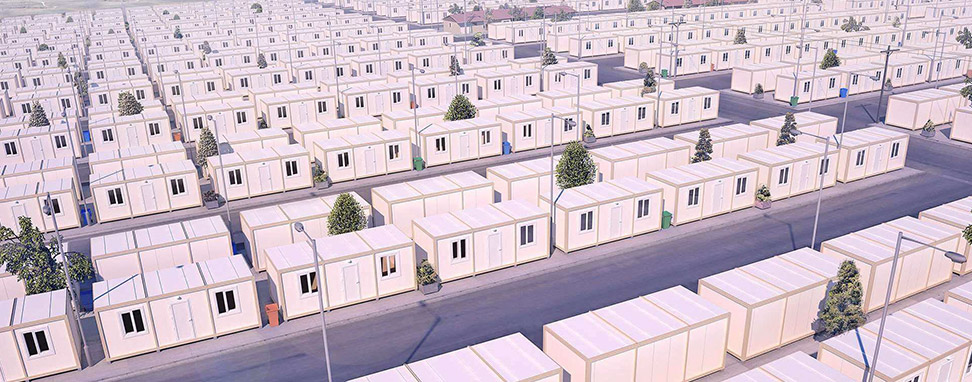With the acceleration of global urbanization and the increasing demand for environmentally friendly and energy-saving buildings, traditional residential forms are gradually facing challenges in space, resources and the environment. Against this background, metal container houses (Metal Container House) as an innovative living solution have gradually come into people's view. Metal container houses not only provide modern living space, but also meet the needs of environmental protection and sustainable development, becoming an emerging force in modern architectural design.
Metal container houses, as the name suggests, are a form of housing that uses abandoned metal containers as the main structure of the building. Containers were originally used to transport goods, but with the change of design concepts and the advancement of construction technology, these containers that were once regarded as "waste" can be transformed into efficient, practical and creative living spaces through clever transformation and design.
Metal container houses are made up of multiple containers spliced or stacked. After special design and transformation, the interior and exterior can be customized according to the needs of the residents. Their structure is strong and durable, and they have good earthquake and wind resistance, adapting to the needs of different climatic conditions.
One of the biggest advantages of metal container houses is their economy. Compared with traditional brick-concrete structures, container houses are cheaper to build. This is because containers themselves can be used directly as building materials, reducing many materials and processes required in traditional buildings. At the same time, container houses have a shorter construction period, saving a lot of time and labor costs.

Container houses use abandoned shipping containers, which can not only extend the service life of these metal structures, but also effectively reduce the generation of construction waste, which meets the needs of modern society for sustainable development. In addition, the design of container houses usually focuses on energy conservation, such as the use of green technologies such as solar energy and rainwater recycling, so that residents can be more environmentally friendly and energy-saving.
Metal container houses are highly flexible and scalable. Due to the standardized size of containers, architects and designers can choose different numbers and layouts of containers for splicing or stacking according to actual needs. This flexibility allows metal container houses to adapt to various space requirements, from single cabins to multi-story buildings. Moreover, the expansion and transformation of container houses is also very simple. As family members increase, the expansion of space can be achieved by simply adding more containers.
Containers themselves are designed to carry heavy objects and adapt to complex transportation environments, so they have extremely high structural stability. Metal container houses can effectively resist natural disasters such as storms and earthquakes, and are a very safe choice for living.
Modern metal container houses are designed with more emphasis on aesthetics and comfort. Designers can not only cleverly integrate the industrial feel of containers with modern home design, but also add functional elements such as insulation and sound insulation to the interior of the house, making the indoor environment more comfortable. The simple and modern appearance makes container houses visually more fashionable and avant-garde compared with traditional houses.
Due to the short construction period and low cost, metal container houses are very suitable for use as emergency housing. Whether it is a temporary shelter after a natural disaster or temporary accommodation in a refugee camp, container houses can be quickly built and provide basic living security. In addition, container houses are also often used in places with a large demand for temporary accommodation, such as construction sites and mining areas.
In recent years, more and more people have begun to choose metal container houses as part of vacation homes or resorts. Because container houses are flexible in design and can be integrated into the natural environment, many resorts choose to use them as simple and stylish living units, which can not only provide a comfortable living experience, but also increase the unique charm of the resort.
In many developing countries, metal container houses have become an effective way to solve housing problems. Especially in areas with rapid urbanization, container houses can quickly provide people with shelter while reducing construction costs. For families with limited financial resources, metal container houses are an ideal low-cost solution.
In addition to residential use, metal container houses are also widely used in the construction of offices and commercial spaces. Many startups, design studios and retail stores choose to use offices converted from containers, which not only saves money but also gives the space a modern and creative atmosphere.
Although metal container houses show great advantages in many aspects, they also face some challenges. For example, containers have poor insulation, so additional insulation layers are required; in addition, the design limitations of container houses may also affect the needs of some users. However, with the continuous advancement of technology and the continuous innovation of architectural design, these problems are gradually being solved.
Metal container houses are expected to become an important trend in the global construction field. As people pay more attention to environmental protection, energy saving and low-carbon living, container houses will continue to develop and may become an important choice for solving urban housing problems and sustainable buildings.
Metal container houses are a modern architectural form that combines innovative design with environmental protection concepts. With its economy, environmental protection, sturdiness and high flexibility, metal container houses have become an important living solution. With the continuous development of construction technology, this new type of housing will be further optimized and gradually move towards wider applications, promoting the development of modern living methods and becoming an important force in the future construction field.








